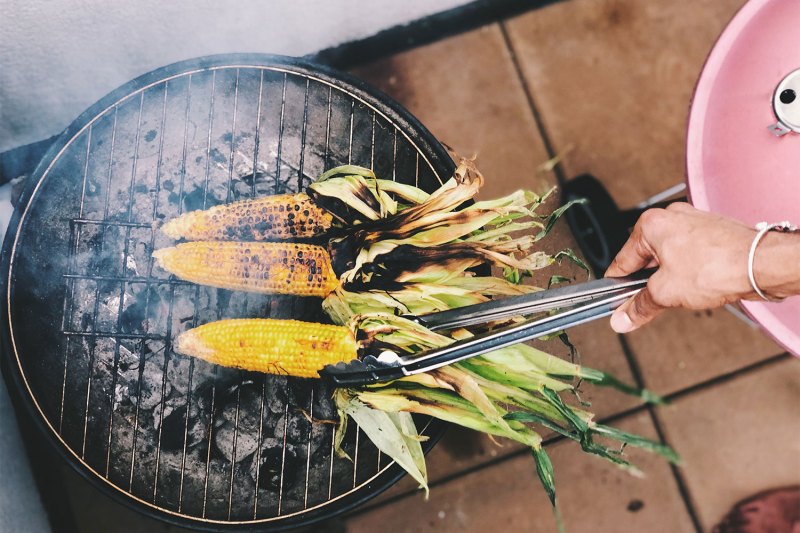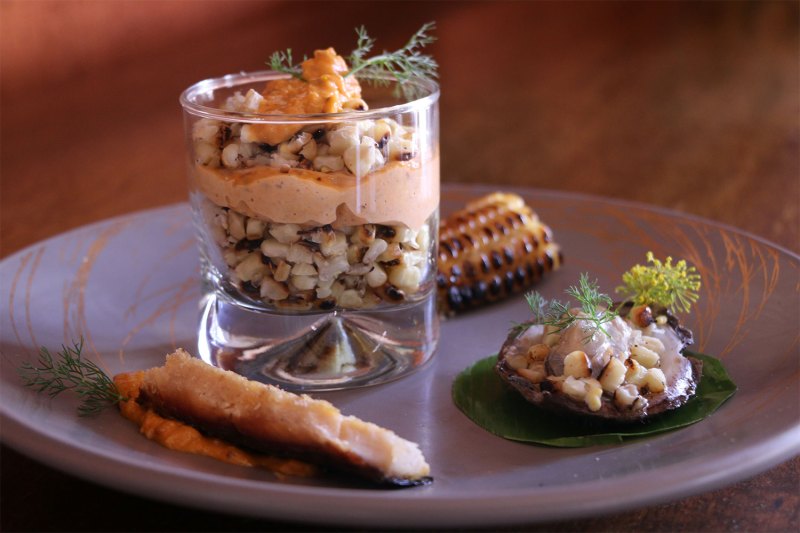The simple, pure pleasure of firing up the grill and enjoying a spread of meat and vegetables with that signature char is, without a doubt, among summer’s greatest gifts. That’s why the frequent appearance of boiled corn on the cob at barbecues and summer potlucks can feel like a missed opportunity. If you’re already throwing your burgers, hot dogs, and veggie skewers on the grill, then why not give your fresh summer corn the same treatment?
The natural sweetness of corn becomes more pronounced (and more delicious) when the heat and smoke of a charcoal or gas grill brings a welcome level of toastiness. Grilled corn tastes fantastic with a slather of butter and a sprinkle of salt, but if you’re looking for an alternative that offers creaminess, acidity, and a hint of heat, then you’ll be well-served by making elotes a regular part of your home-barbecue rotation.
What are elotes?
A massively popular street-vendor staple found throughout Mexico and Central America, elotes begin with corn on the cob, either boiled, steamed, roasted, or grilled. Next, the elotes maker will combine crema (or mayonnaise) and lime juice, spreading the mixture over the warm corn cob. Finally, the cob gets rolled in a blend of Cotija cheese and chili powder. The corn is traditionally served right on the cob, making elotes ideal snacks to enjoy during a summer stroll or a picnic.
For executive chef Frank Valdez of Broken English in Chicago, elotes conjure up fond memories of childhood: “When I think about my earliest experience with elotes, I am instantly transported to my grandmother’s tiny kitchen in Salinas, a small town in the state of San Luis Potosí in central Mexico. The thing I remember most is the smell emanating from the comal of the fresh corn being toasted. It’s similar to the smell of popcorn cooking over a campfire. [I remember] the crackle and pop of the corn as it begins to char to signify they are ready to be eaten.”
What are esquites?
“Elotes” specifically refers to corn eaten directly off of the cob, but some chefs, home cooks, and vendors instead choose to remove the cooked kernels, season them, and serve them in cups. The resulting treat, known as esquites, is a personal favorite of Valdez’s, who tells us that “my grandmother made esquites — toasted corn off the cob, served warm with chopped cilantro, Serrano peppers, crumbled cheese, and a squeeze of fresh lime juice. It was as close to perfection as can be because the corn wasn’t relegated to being a side dish, but was cast as the star of the dish. [Esquites are] less messy, easy on the teeth, and [they give you] consistent flavor in every bite.”
Ready to make your first elotes or esquites? Follow these tips:
Keep the corn inside its husk when grilling.
To give your corn a toothsome texture, try this tip from Valdez: “I like to keep the husk on when grilling the corn; it makes for tender, husk-steamed corn and imparts a light smoky taste.” If you’d still like some charred kernels on your elotes, just peel back the husks toward the end of your grill time and let the bare corn roast.
Epazote brings extra aromatic flair to this corn dish.
A classic ingredient used in esquites, epazote is an herb native to southern Mexico and Central America with a taste profile reminiscent of oregano, mint, anise, and citrus. “When I think of esquites, the first ingredient that comes to mind is epazote, which adds a unique flavor to the dish,” says executive chef Orlando Trejo of Hotel Xcaret Mexico in Playa del Carmen. Chefs who choose to boil their esquites corn frequently add epazote to the boiling liquid in order to infuse the corn with its fragrance and flavor, but if you’re grilling your corn, you can finely mince the epazote leaves and stir them into your esquites along with mayo/crema, lime juice, chili powder, and cilantro.
If you’re using mayonnaise, don’t hold back.
Some elotes and esquites makers choose not to use mayonnaise or crema on the corn, instead rely on spices, herbs, seasonings, and veggies to pack all the necessary flavor appeal. Valdez counts himself among this number, explaining that, for his esquites, “I skip the mayo. [That makes my esquites] less heavy, but they have a nice flavor profile. It’s a great alternative for those looking to make a healthier version.”
That said, if you do decide to include mayonnaise, chef/founder Jennifer Scism of Good To-Go recommends really committing to your use of that ingredient. “Don’t skimp on the mayo. If you don’t like mayo, this is not the treat for you. The mayo acts as [both a] flavor AND a glue to keep the cheese and chili stuck to the corn. I’m a big fan of mayonnaise; [it] holds the whole thing together,” she tells The Manual.
Mexican Streetstyle-Inspired Elotes

(By Julio MM, executive chef, Cantina Royal, New York City)
The grilled elotes served at Cantina Royal hark back to chef Julio MM’s childhood — “Growing up in Colonia Roma in the center of Mexico City, with such a rich food scene, where you can go from fine French cuisine to the most amazing street taqueria on the same block, refined my palate more than culinary school did!” he insists.
Ingredients:
- 4 ears of corn, husks on
- 8 garlic cloves, smashed
- Your choice of oil (vegetable, corn, light olive, etc.)
- Spicy aioli*
- Kosher salt, to taste
- Crumbled queso fresco, to taste (Chef Julio mentions that feta or another fresh, crumbly cheese can be substituted for queso fresco if needed)
- Lime wedges
Method:
- Light the grill. Peel back the husks of the corn, remove the corn silk, and soak for five minutes in a cold bath of water and salt.
- While the corn is soaking, whisk the mayo and chili oil together in a small bowl, then put to the side.
- Remove the corn from the salt bath, pull out some tinfoil, and coat the corn cobs in your choice of oil, kosher salt to taste, pepper to taste, two cloves of smashed garlic per cob. Wrap the cobs in tinfoil.
- Transfer the corn cobs in foil to the grill when ready, rotate on the grill for 5 minutes, then remove foil and blacken corn over the open flame until charred to your liking.
- Remove corn from grill, slather in spicy aioli, sprinkle with crumbled queso fresco, drizzle with extra hot sauce (optional), squeeze some fresh lime over the top, and enjoy!
*Spicy Aioli:
- Add 4 oz mayonnaise and 1 tbsp chili oil or chili oil-based hot sauce (Chef Julio prefers Cantina Royal Tia Piky Lux Hot Sauce) to a bowl and whisk to combine.
Esquites With Sea Flavor

(By Betty Vázquez, chef/owner, El Delfín, San Blas, Nayarit, Mexico)
A waterfront region located on Mexico’s Pacific coast, Riviera Nayarit claims to be home to the largest corn cobs in the world. Therefore, it makes perfect sense that Nayarit-based chef (and the region’s Gastronomy Ambassador) Betty Vázquez takes enormous pride in her esquites recipe, which she prefers to pair with white fish and shellfish native to the area.
Ingredients:
- 2 cobs of corn, roasted or grilled
- 1 slice of grilled mullet (if mullet isn’t available, Chef Betty advises swapping in a different white fish)
- 1 cup of mayonnaise
- 4 tablespoons of chopped onion
- 2 tablespoons of huichol sauce or concentrate from a ground guajillo pepper (made by cooking only the seedless skin in water and grinding)
- ½ teaspoon of vinegar
- 1 slice of fresh oyster
- Vinaigrette*
Method:
- Remove roasted corn from the cob and set aside a few kernels for the oyster.
- Create a dressing by combining mayonnaise, chopped onion, huichol sauce (or ground guajillo pepper), and vinegar and whisk to mix.
- Add the dressing to the roasted corn kernels and stir to combine.
- Top the oyster with vinaigrette and reserved corn kernels.
- Serve the esquites alongside the grilled mullet and the oyster. Garnish with fresh dill flower.
*Vinaigrette:
- Add olive oil, oyster juice, lemon juice, and salt to a bowl and whisk to combine.
Editors' Recommendations
- Need to Elevate Your Pasta Dishes? Learn How To Make Pesto
- The 7 Best Flavored Whiskies to Add to Your Bar
- Up Your Squash Game With These Vibrant Recipes
- Spice Up Your Grill Game With This Chorizo Burger Recipe (and Some Malbec)
- All Soup For You: 8 Refreshing Chilled Soups To Add To Your Summer Menu


